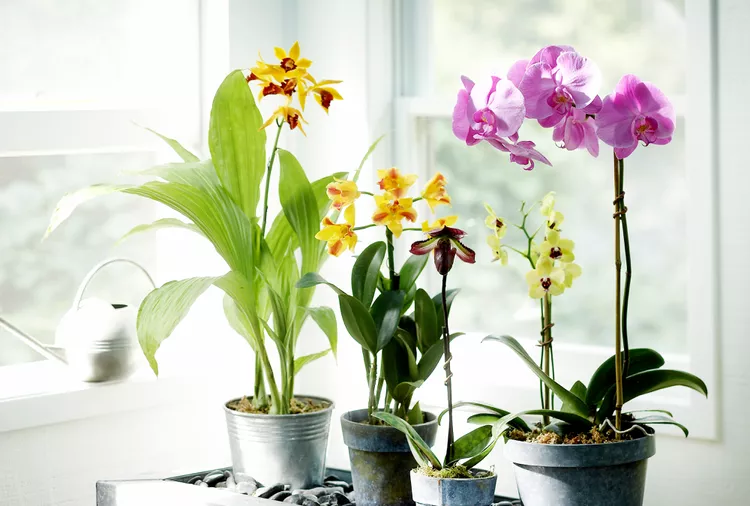Orchids are a singular group of plants with gorgeous blooms that have inspired superfans and appreciation societies. However, if you want to make more of a favorite variety, how to propagate orchids is a little different than propagating other houseplants. You can’t just snip a cutting and stick it in a pot of rooting medium or glass of water. Orchids take more work and the technique to use depends on their growth pattern. This guide covers the two main propagation methods: keikis and division.
Justin Kondrat is lead horticulturist at the Smithsonian Gardens Orchid Collection, where he cares for the nation’s orchid garden.
Types of Orchids to Propagate
“There are over 30,000 naturally occurring species [of orchids] and around 115,000 hybrids that have been registered,” says Justin Kondrat, lead horticulturist for the Smithsonian Garden Orchid Collection in Suitland, Maryland. All those orchids fall into two general growth patterns, and you need to know an orchid’s growth pattern before you propagate it.
Monopodial Orchids
“These orchids grow on a central stem that doesn’t branch out,” Kondrat says. ”They produce flower spikes and aerial roots from that main stem, specifically at the point where leaves join the stem. Phalaenopsis, or moth orchids, fall into this category, as do vanda orchids.”
“A monopodial orchid reproduces by forming a baby orchid plant called a keiki at its base or on flower spikes after they’ve bloomed,” Kondrat says. Keiki is a Hawaiian word that means baby. To propagate the orchid, remove this baby orchid and put it in its own pot.
Encourage monopodial orchids to make a keiki with a liquid plant hormone called keiki cloning paste. “Scar the orchid stem near its base or on the flower spike and put keiki paste on it,” Kondrat says. “It will trigger the orchid to produce a keiki.”
Sympodial Orchids
These orchids grow new plants from a rhizome or bulb. Cattleyas and oncidiums fall into this orchid category. They usually don’t make a keiki. Their rhizomes make a thickened area called a pseudobulb, where new plant shoots grow, sort of like an iris.
“You propagate these orchids by division like you would with your typical perennial,” Kondrat says. Some sympodial orchids, like dendrobiums, make keikis, but dividing its rhizomes is the most common way to make new plants.
When to Propagate Orchids
Propagate an orchid after it has finished blooming. If a keiki forms sooner on a monopodial orchid, you can cut it off while the plant is blooming and put it in its own pot.
Propagate a sympodial orchid when the plant outgrows its pot. When you see pseudobulbs and new roots and shoots pushing up around the main plant, it’s time to divide the orchid. “You never want to divide a plant that isn’t healthy and thriving,” Kondrat says.
If your orchid looks less than healthy, feed it and get it healthy before you cut it into pieces, which is essentially what you’re doing when you divide the plant. “Dividing an orchid disturbs it, so do it in conjunction with repotting it,” Kondrat says.
How to Propagate Orchids
Here’s how to make new plants from your mature orchids.
Propagation by Keiki
Once a keiki has three or four roots, it’s ready to be cut off the parent plant. Use a clean and sharp cutting tool like snips or a knife to cut the keiki from the flower spike. Place the keiki in a small pot with orchid growing medium. If it’s a small keiki, pot it in sphagnum moss, Kondrat says. Keep the medium or moss moist, but don’t overwater.
Propagation by Division
Gently remove the orchid from its pot. Look at the plant to identify the pseudobulbs that will make good divisions. They should have new leaves or shoots growing out of them and some roots beginning to form. A good-sized division has three to five pseudobulbs, depending on the type of orchid. Cut the plant apart with a sharp cutting tool, separating the divisions. Place each division in a small pot with sphagnum moss and keep it moist, but don’t overwater, Konrat advises.
How to Fertilize Keikis or Divisions
Wait a month before fertilizing the newly potted keiki or division. Konrat says, “I would give them a little time to settle, just so they can get themselves anchored. Once the roots elongate, they’ll have more surface area to absorb nutrients.” Konrat recommends using a fertilizer formulated for orchids with an N-P-K nutrient ratio of 20-20-20, diluted to 20 percent of the recommended amount.
Kondrat also recommends using diluted fertilizer throughout an orchid’s life, not just when starting a new plant. “When you think about how an orchid grows in the native environment, it’s constantly getting a little bit of food here and there when a bird flies by and poops on it or when stuff drips from the bark on the trunk that it’s growing on,” Kondrat says. Duplicate that by giving your orchid weak fertilizer constantly during spring, summer, and early fall, he says.




















